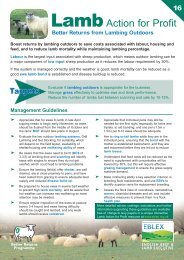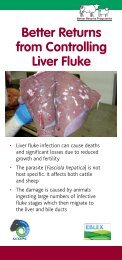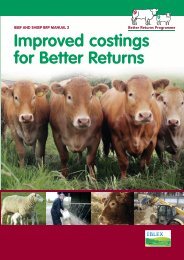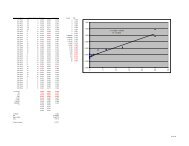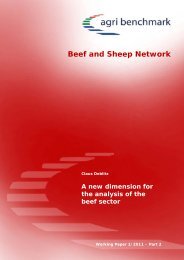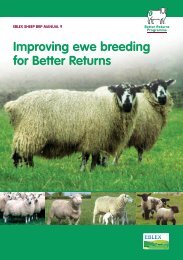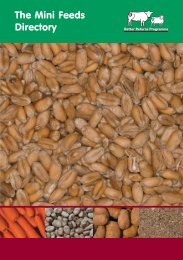Booklet - Breed a Better Pedigree Flock - Eblex
Booklet - Breed a Better Pedigree Flock - Eblex
Booklet - Breed a Better Pedigree Flock - Eblex
You also want an ePaper? Increase the reach of your titles
YUMPU automatically turns print PDFs into web optimized ePapers that Google loves.
18<br />
11. Making faster progress by harnessing new technologies<br />
Avoiding inbreeding<br />
To optimise rates of genetic gain within<br />
conventional programmes, breeders need<br />
a balance between maximising rate of<br />
genetic gain in traits of interest and<br />
minimising rates of inbreeding.<br />
Inbreeding - the practice of mating related animals - is to a<br />
degree inevitable within any long-term selection programme<br />
involving a closed population.<br />
While some breeders will deliberately inbreed specific<br />
bloodlines to fix certain characteristics into the flock,<br />
this can lead to inbreeding depression - a decline in<br />
performance often associated with traits of low heritability,<br />
eg those affecting reproduction, longevity and disease<br />
resistance.<br />
Software can now help breeders measure rates of<br />
inbreeding so that they can make faster rates of genetic<br />
gain without risking increased levels of inbreeding.<br />
Reproductive technologies<br />
Several reproductive techniques enable producers to<br />
increase rates of gain within their breeding programmes.<br />
These include artificial insemination (AI) and embryo<br />
transfer (ET).<br />
These techniques enable greater use of elite genetics as<br />
well as increasing rates of gain by decreasing generation<br />
intervals. Semen storage provides a cost-effective insurance<br />
against a ram being lost and, due to domestic and<br />
international demand for semen, can generate valuable<br />
income.<br />
These techniques will ultimately lead to production of<br />
superior breeding stock, but they tend to be expensive. An<br />
investment in reproductive technologies must be recouped<br />
through increased pedigree sales.<br />
Molecular genetics<br />
Conventional breeding programmes are based on<br />
“quantitative genetics”; the selection of heritable<br />
characteristics that show continuous levels of variation<br />
(such as growth rate) and are controlled by a number of<br />
genes. Selection has been based on the effects of genes,<br />
rather than the genes themselves.<br />
In recent years, great strides have been made in the study<br />
of molecular genetics. In future, livestock breeding<br />
programmes will make use of information that explains what<br />
is happening at the molecular level, ie within the DNA itself.<br />
Molecular techniques that will influence breeding in future<br />
include:<br />
Molecular markers. Areas within DNA (markers)<br />
that can be located through lab tests and are closely<br />
associated with areas of DNA thought to be<br />
important for specific traits.<br />
Genome mapping enables informed choices to be<br />
made based on the position of functional genes within<br />
the DNA.<br />
For example.<br />
Scrapie genotyping is a molecular technique whereby sheep<br />
with certain genes are known to be more resistant to<br />
scrapie. These animals can now be identified through<br />
blood testing.





